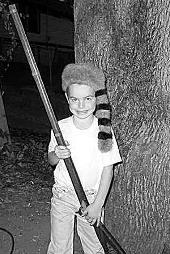Disney in the Classroom
Page 2 of 5
With all of this stirring
around in people's heads, perhaps the Davy Crockett phenomena should not have
been such an unexpected occurrence. Yet, no one, especially not Walt Disney,
expected the Davy Crockett fad. The series became so popular that Fess
Parker could not go out in public without being mobbed. Every little boy had
to have a coonskin cap and a long rifle. Everyone watched the three
television programs and demanded more. (Despite the fact that Mr. Crockett
died in the last episode.) Disney ended up putting the episodes
together and releasing them as a movie; which packed theaters all over the
country. Then he created three series pre-quels to give people even
more Crockett.
Why this mania for Davy
Crockett? I believe its because Davy projected an image of how Americans
wanted to perceive themselves. Crockett was presented as a faithful friend
who was charming and willing to risk his life to help others. He was even
willing to die for what he believed was right. For Davy Crockett what was
right was more important than what was profitable. He had little to gain by
helping the Indians or the Texans and he in fact destroyed his political
career and eventually lost his life by doing so. However, he died a man who
had made a difference; not just a man who had made money.
I have my student watch
several clips from the Davy Crockett television episodes. We then discuss why
Americans needed to believe in a hero like Crockett, and how the mania for the
series can be explained by this need. I then have each student write about
whether he or she believes that Davy Crockett is a good role model for
Americans today.

A typical Coonskin pioneer ;o)

(c) Disney
"Mouseketeers reinforced day after day a subtle sense of
what mattered--
a well-groomed appearance, inquisitiveness and a
willingness to learn, politeness and good manners, a friendly personality, and
respect for authority."
-Watts p. 341
If Davy Crockett displayed the values that 1950's
American adults (and little boys ;o) wanted to identify with; the Mouseketeers
were the decade's role models for pre-teen boys and girls. The Mickey
Mouse Club was a variety hour with song and dance routines, comedy skits,
newsreels, inspirational stories, cartoons, serials, and more. However,
the show was much more than just entertainment for the young. Disney
carefully selected the Mouseketeers as representatives of the best of American
youth. The young actors and actresses were polite and enthusiastic; whether
they were performing a dance routine or were acting in a serial like Spin
and Marty. On and off camera they were presented as dutiful sons and
daughters; willing to help out in the home and willing to work together to
achieve goals. When the Mouseketeers faced common teenage problems (in skits
and serials) they solved these problems using kindness, morality, and good
humor. The show also used newsreel segments to show the achievements and
character of actual teenagers. The Mickey Mouse Club made it clear
that if you made the right choices you could be an outstanding member of
American society, no matter how old you were.
I use clips from several Mickey Mouse Club
shows to demonstrate the values that Americans wanted their teenagers to have
in the 1950's. We discuss why parents wanted their children to have these
values, and whether it was realistic for teenagers to have these values. I
then have students write about whether the values promoted by the Mouseketeers
have a place in our culture today.
Annette!
(c) Disney
